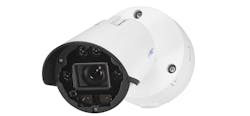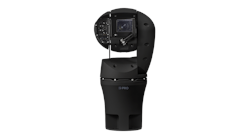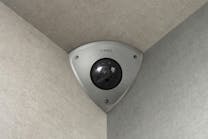DIY Defense: Self-Installed Home Security Solutions
July 19--A man's home might be his castle, but for decades he's largely been forced to rely on someone else to defend it. Thanks to the advent of cheap self-install security kits built around smart technology, however, the days of being forced to subscribe to a monitored alarm company -- or buy a dog and gun -- are over.
In the last two years, all-in-one solutions from companies such as Oplink Connected, SimpliSafe, SmartThings and Wink have hit shelves, turning affordable home security into more of a do-it-yourself affair with kits starting as low as $200.
These systems are designed to be easy to set up and can be controlled remotely via a smartphone app. And because they are monitored by owners instead of an outside company, they sidestep the monthly fees charged by contracted security services such as ADT or Xfinity Home, Comcast's recently introduced security/automation service.
Last year, Strat Parrott, 30, purchased a kit equipped with a digital video recorder and four cameras to monitor his property and keep tabs on his father at their home in East Chattanooga.
The system is Internet-connected, so he can monitor it remotely via a smartphone or web browser. So far, Parrott says, it has gone largely unused -- although it did help locate a lost dog (found under some stairs) and solve the mystery of a broken back window at a neighbor's house (a local kid did it) -- but he liked the added sense of security add in four more cameras.
"We have dogs and [my dad] has got a gun, but that really doesn't help if you don't have anything that can show you what actually happened and get pictures of faces," he explains. "I really like having the video system a lot better. I feel like it's better because you can see what's happening rather than just hearing what's going on."
TAKING SECURITY TO THE BANK
According to a 2013 study by global electronics industry analyst IMS Research, the residential market for home security systems in 2012 was worth $1.1 billion. Between 2012 and 2017, researchers predict the industry will experience a compound annual growth rate of 5.3 percent.
Analysts suggest much of the future expansion in DIY home security will be tied up in its ability to seamlessly integrate the features of security systems into existing "smart" home networks alongside devices such as Bluetooth-controllable light fixtures and automated locks.
It's all leading to a shake up in residential construction.
"It used to be that you would have to wire a house for a security system, but that's something that's trending out," said Tina Frizzell, the vice president of Pratt Home Builders on Hamm Road, in a 2013 interview with the Times Free Press. "We used to do security systems in all our homes, but now people are saying, 'Mine will be wireless. I'm OK.'"
To some extent, the home automation and home security markets already are starting to intertwine. In 2011, Google spent $3.2 billion to purchase Nest Labs, the makers of the Nest Learning thermostats and Nest Protect smoke/carbon monoxide detectors. Nest, in turn, spent $555 million in June to acquire Dropcam, which manufactures Wi-Fi-equipped cameras that securely stream live video feeds to the cloud, bypassing the need for local storage at the home.
Not all DIY systems are "smart" enough to store their video footage off-site, however, and that's where Christopher King steps in. The owner of King Security Cameras in Ringgold, Ga., King will visit customers' homes after they've purchased one of his cameras to connect them to the client's home network and to set up the DVR that will record their video feeds.
Since opening his doors in October, King says he's installed dozens of systems around the region and that there's a "definite upswing" in interest in self-installed systems, a trend he attributes to lowering prices and ease of use. And, with the advent of cameras that record in 960H, a new high-resolution standard, video cameras in some high-end kits are more effective that ever, he says.
"That's the new hot thing right now," King says. "The quality of the picture it's recording has significantly increased. Every now and then, you'll see someone on the news with videos that look like they were shot by a camera from the '80s, and it's still possible, if you buy a cheap system, to get bad quality like that."
Even more than a high-quality picture, however, King says customers want to make sure their security system is as smart as their other devices.
"The biggest thing is that everyone wants to be able to view it from a smartphone," King says.
SMARTER SECURITY
Because of the increasing automation of the home security market, however, the ability to remotely monitor video cameras barely scratches the surface of what DIY systems are capable of.
Most self-installed kits are built around a central hub or base station, which serves as a kind of nerve center for the home, coordinating the functions of components such as sensors that detect when doors are opened or triggers alarms when a window is broken.
Users with systems made by Oplink can integrate additional components such as cameras that allow users to remotely open their garage doors or infrared-equipped cameras that automatically begin recording when they detect movement.
With the recent formation of competing home security manufacturers, there are now about a dozen competing protocols -- think Macs versus PCs -- in the marketplace. Some standards are more specific -- Oplink's infrared cameras only work with an Oplink hub, for instance -- but many manufacturers tout their system's ability to integrate with multiple standards as a major selling point.
The compatibility list for SmartThings' $99 central controller hub includes "hundreds of smart devices," from Bluetooth door locks to moisture sensors. Through the simplified programming interface accessed via a free smartphone app, users can create "actions" that automatically will be triggered by the hub when certain conditions are met, such as turning on motion sensors when the owner leaves a pre-established perimeter.
The Wink hub, an $80 device that can simultaneously control more than 200 connected devices, offers support for 15 different device brands and more than 60 smart products, according to the manufacturer's website.
Thanks to the increasing automation of DIY security systems, once a homeowner establishes their defensive parameter, King says, they can all but forget about it.
"DIY systems are designed to be self-supporting, so you don't have to do very much once they're installed," he says. "There's actually no upkeep required, except to occasionally check your cameras to make sure they're not covered by spiderwebs or things like that."
NO-CONTRACT? FEWER FEATURES
Most of DIY systems are contract-free, but some manufacturers require optional monthly service plans to access some features.
-- Oplink kits feature free email notifications out of the box, but adding automatic notifications to emergency contacts and video streaming/recording requires a $10-per-month subscription. Add-on services such as camera or sensor monitoring are an additional $10 per month.
-- SimpliSafe's kit functions as a local alarm, by default, but in order for the system to send text or email alerts, users must opt into a monthly subscription that's a minimum of $20 per month. Remotely accessing the system's features requires a $25 monthly subscription.
-- The Iris Home Management System, which has major backing from Lowe's, sells kits for as low as $179, but many of its most-touted features, including email/text/call alerts, voice control, live streaming and "advanced control," require a subscription plan that's free for the first two months, after which it increases to $10 per month.
INSURANCE DISCOUNT
According to a 2014 press release from the Insurance Information Institute, homeowners who invest in a home security system can expect to see a minimum discount of 5 percent off their insurance premiums. For systems that include more advanced safety features, the discounts could increase to as much as 20 percent with some providers.
-- State Farm: In order to get the best discount, homeowners must have a fire extinguisher on the site, install deadbolt locks and prove that their security and alarm system is connected to a central reporting agency.
-- Allstate: Spokesperson Allison May says the company's Protective Device Discount can reduce premiums by as much as 15 percent. Higher discounts are available for homes that have burglar/fire alarms as well as sprinklers, keycode security systems and fire extinguishers. Receiving a discount for a self-installed system may require documentation such as receipts or certificates from a monitoring company.
-- Farmers Insurance Group: Client premiums can be reduced many security features and lifestyle chances, including not smoking, installing window locks, maintaining smoke detectors and "install[ing] a security system with an outside signal and connection to local police."
THE BENEFITS OF SECURITY
Home security systems, both monitored and self-installed, have long-established links to a reduction in the risk of break-ins.
According to a 1992 study conducted by Temple University economics professors Simon Hakim and Andrew Buck, homes equipped with home security systems are up to three times less likely to be burglarized as homes without alarms. The study also found that homes with alarms, even when broken into, experienced an average of $675 less in losses, when adjusted for inflation.
More recently in 2009, researchers at Rutgers University's School of Criminal Justice released a paper demonstrating significant links between the prevalence of homes equipped with security systems and a citywide reduction in crime.
For two years, researchers analyzed five years of crime statistics in Newark, N.J., whose rate of 708 robberies per 100,000 people is the nation's third highest, according to the FBI's 2012 Unified Crime Report. Their study, which was funded by the Alarm Industry Research and Educational Foundation, the nonprofit research arm of the Electronic Security Association, found a steady decrease in crimes between 2001 and 2005 that coincided with the rising number of registered homes with burglar alarms.
Just as otherwise-harmless insects scare off potential predators with their vivid coloring, burglars say even the hint that a home might be protected can be an effective deterrent.
Of 30 active burglars interviewed by the Rutgers researchers, more than 90 percent said they preferred to burglarize a home without a home security system. About 75 percent of the burglars said they had called off a burglary at a residence based solely on the presence of a sign or window sticker indicating that the target home was protected by an alarm.
The study even showed that alarm systems can have an area of effect beneficial to the entire community. According to the study, neighborhoods with a high-density of alarms saw fewer burglaries than those with fewer alarms.
"Street blocks or small sectors of [Newark] with high installation rates of burglar alarms tend to have less ... burglary," the study reads. "The installation pattern ... showed some positive impact on residential burglary by pushing away potential burglar(s) from the highly concentrated areas of burglar alarms."
Contact Casey Phillips at [email protected] or 423-757-6205. Follow him on Twitter at @PhillipsCTFP.
Copyright 2014 - Chattanooga Times Free Press, Tenn.





